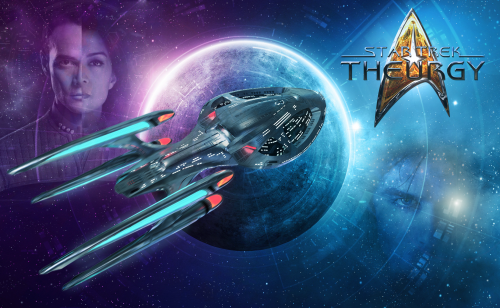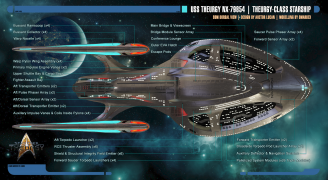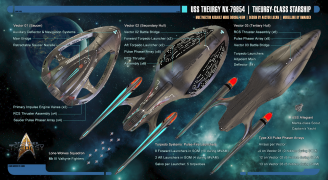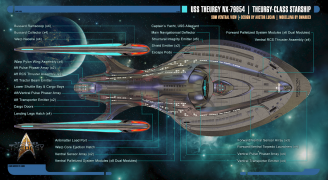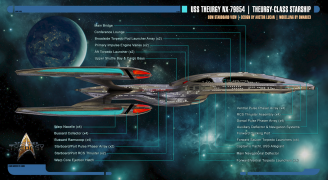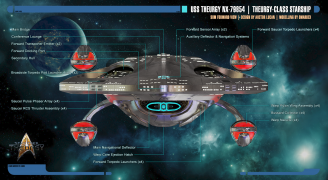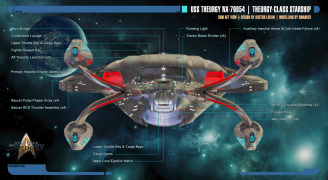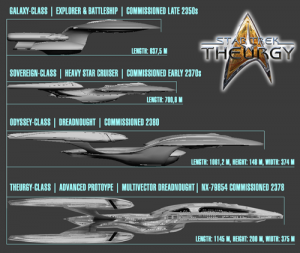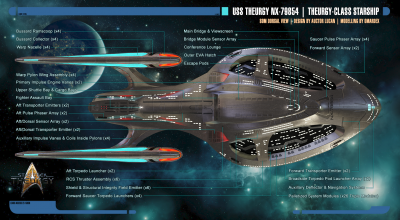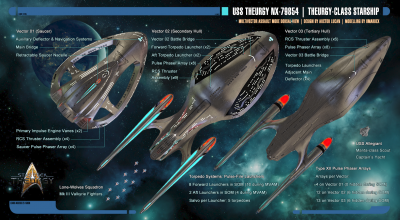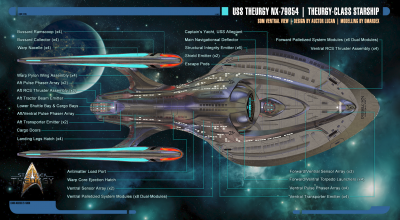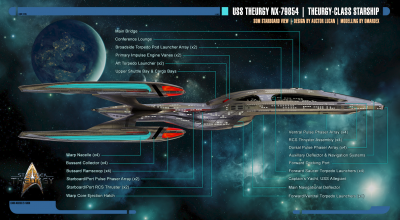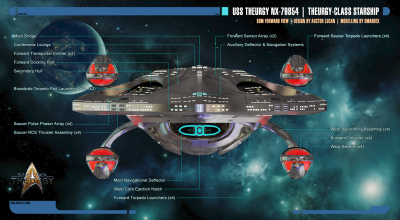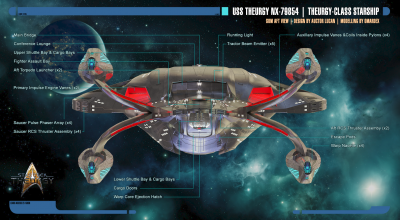USS Theurgy
From Star Trek: Theurgy Wiki
UNDER CONSTRUCTION
The Theurgy-class is meant to be the pinnacle of Federation starship design and will carry the Federation into a new generation of exploration in the next century. It is one of the largest starships ever created by Starfleet, surpassing even the Odyssey-class in size. The USS Theurgy is the only one built, and exists as an advanced prototype of its class until it is taken into production. Officially, both the Odyssey and the Theurgy-classes were rushed into production because of the Romulan Civil War. Unbeknownst to the public of the Federation and Starfleet as a whole, it was the corrupted Starfleet Command that pushed the production ahead of schedule for sake of their own clandestine agenda.
The Theurgy is a Multivector Dreadnought, designed for long-range exploration, diplomacy, and deterrence. It's expanded science laboratories allows it to take on extended missions that will take it far from a starbase or other Starfleet facilities. The Theurgy-class has ample room for cargo or passengers, and will easily be tapped for rescue missions or civilian evacuations in war zones when it is taken to mass-production. A Theurgy-class vessel also has regenerative shielding, ablative armour and multivector assault mode (MVAM) - in which the ship is able to attack enemies from three different directions simultaneously (Note: This feature was seen in detail in the Star Trek Voyager series - Episode 14, "Message in a Bottle", Season 4 - where a Prometheus-class starship was able to use this feature).
Schematics
Theurgy-class (Dorsal View)
Theurgy-class (Dorsal MVAM View)
- THEURGY-CLASS-MVAM-STARBOARD.png
Theurgy-class (Starboard MVAM View)
Theurgy-class (Ventral View)
Theurgy-class (StarboardView)
Theurgy-class (Forward View)
Theurgy-class (Aft View)
Technical Specifications
General Information
| Vessel Name: | USS Theurgy |
| Registry: | NX-79854 |
| Starship Class: | Theurgy-class |
| Starship Type: | Multivector Dreadnought |
| Production Status: | Advanced Prototype |
| Purpose: | Exploration, Diplomacy & Deterrence |
| Constructed: | Antares Fleet Yards & Utopia Planitia Fleet Yards |
| Commissioned: | October 9th, 2378 |
| Dedication: | "Courage is fear, when it has said its prayers." |
| Decks: | 30 |
| Standard Crew Complement: | 980 in total
Officers: 170 |
| Dimensions: | Length: 1145 m
Height: 200 m |
| Mass: | 4,709,700 ton in SOM (Standard Operation Mode)
Total mass divided between 3 vectors during MVAM |
Computer & A.I.
| Computer Cores: | 3 AC-16 Bio-Neural Computer Cores (Slaves) |
| Specifications: | LCARS 5 System Software 984 megaquads isolinear storage capacity
47 million data channels |
| Positronic A.I. Brain Core: | Sentient Soong-Legacy Protoype (Master) |
| Autonomous A.I. Projection: | Federation Isomorph Prototype Ver. 7.5 |
| Specifications: | Stand-alone cortex processor w 60,000 operations/ns capacity Stand-alone duranium crystal |
Propulsion Systems
| Thruster Systems: | Magneto-Hydrodynamic RCS Thruster Assemblies |
| Outlets/Vector: | 24 on Vector 01 (4 hidden during SOM)
22 on Vector 02 (16 hidden during SOM) |
| Output: | 4.5 million newtons per outlet |
| Impulse Propulsion System: | 6 Sovereign-class IPS Engines |
| Power Output: | 85 gigawatts per engine |
| Standard Impulse Velocity: | 0.30c speed of light |
| Full Impulse Velocity: | 0.983c speed of light |
| Warp Drive System: | 3 Class 9 Warp Cores |
| Power Output: | 250 petawatts + 145 petawatts |
| Standard Cruising Speed: | Warp Factor 7,5 |
| Maximum Cruising Speed: | Warp Factor 9.2 |
| Emergency Speed: | Warp Factor 9.995 for an 25 h duration |
Tactical Systems
| Shields: | Class 5 Regenerative Subspace Graviton Field |
| Power Output | 11.700 gigawatts |
| Standard Shield Range: | 20 m from hull |
| Defences: | Heavy duranium/tritanium double hull
50 cm ablative hull armor |
| Phaser Systems: | Type XII Pulse Phaser Arrays |
| Strength and Power Output: | 85 gigawatts, with both beam and bolt firing options |
| Effective Range: | 1,500,000 km |
| Bolts per Minute: | 240 bolts per array |
| Arrays per Vector: | 4 on Vector 01 (0 hidden during SOM)
12 on Vector 02 (6 hidden during SOM) |
| Torpedo Systems: | Pulse-Fire Launchers |
| Number of Forward Launchers: | 8 during SOM (10 during MVAM) |
| Number of Aft Launchers: | 2 during SOM (4 during MVAM) |
| Salvo per Launcher: | 5 torpedoes |
| Range: | 4.000.000 km |
| Full Complement: | 400 torpedoes |
| Torpedo Types: | 125 Quantum & 275 Photon |
| Broadside Pod Launcher Arrays: | Integrated Torpedo Pod Systems |
| Torpedo Type: | Type V Micro Photon Torpedoes |
| Torpedo Yield: | 30-50 % of standard photon torpedoes depending on impact |
| Number of Launcher Arrays: | 2 (1 on each side of the ship) |
| Pod Launchers per Array: | 18 during SOM (21 during MVAM) |
| Max Pod Complement: | 3 per launcher (54 pods per array during SOM, 108 in total) |
| Pod Ordinance: | 15 torpedoes per pod (270 torps per full broadside salvo during SOM) |
| Maximum Launching Rate: | 15 seconds between pods |
| Pod Reload: | 2 minutes once a pod reaches the launcher via tractor beam or auxiliary craft |
| Max Reserve Torpedo Complement: | Additional 90 micro-torpedoes per launcher
(total of 1890 ship-wide for the pods - exclusive of fighter stores) |
| Pod Control Capabilities: | Max 36 deployed pods simultaneously (18+18 pods per array)
Up to 18 additional pods per module with PSM Pod Control Modules installed |
| Palletized System Modules (PSMs): | Integrated Module Capability |
| Number of Dual Modules: | 16 (ventral side of the ship during SOM) |
| Number of Triple Modules: | 26 (dorsal side of the ship during SOM) |
| Installed Pallets: | Sensors (broad-spectrum and specialized)
Communications, Command and Control (flagship complements) |
Auxillary Systems
| Sensor Systems: | Multi-Modal Type |
| Range: | 22 light-years |
| Tactical Sensors: | Multi-Modal Type |
| Range: | 22 light-years |
| [b]Transporter System:[/b] | Personnel & Cargo |
| Range: | 40.000 km |
| Navigational Deflector Dish: | Molybdenum & Duranium Mesh |
| Power: | 6 Graviton Polarity Generators |
| Output: | 400 gigawatts |
| Field Strength: | 650 millicochranes |
| Tractor Systems: | 3-15 Gigawatt Multi-phase Graviton Polarity Source |
| Field Strength: | 480 millicochranes |
| Minimum Range: | 230 million tons at 2 km |
| Maximum Range: | 1 ton at 30.000 km |
Support Craft
| Shuttle Bays: | 2 (Upper Shuttle Bay & Lower Shuttle Bay) |
| Craft Manifest: | 8 Type 9 Shuttles
8 Type 11 Shuttles 2 Danube-class Runabouts 1 ARGO-type Shuttle 8 Workbees |
| Fighter Assault Bays: | 1 on Deck 15 |
| Craft Manifest: | 11 Mk III Valkyrie Federation Attack Fighter Prototypes
5 Mk II Valkyrie Federation Attack Fighters (unmanned fr. the USS Harbinger) |
| Captain's Yacht: | USS Allegiant (Manta-class Scout) |
| Registry: | NX-80978 |
| Class: | Manta-class Prototype |
| Role: | Advanced Scout |
MVAM - Multivector Assault Mode
The ship spends the vast majority of its life in Standard Operating Mode (SOM). Multivector Assault Mode - where the ship is divided into three parts - is typically reserved for battle situations. All hulls, or Vectors, are Warp capable, and thus MVAM can be engaged during warp. This was an original design that had been scraped, since due to the separation of the vessel, each section was only one-third the power of the whole ship. Adding a Battle Bridge and computer cores on each section of the vessel allowed the section to perform more adequately, plus the addition of multiple Sickbays to treat the wounded.
The warp core arrangement is unique. The efficiency of a warp core is in part dependant on its height - the longer a core is, the more accurately the matter and antimatter streams can be controlled. To overcome this, the main warp core has no less than three reaction chambers along its height. During normal operation, matter is fed in at the top of the core and antimatter at the bottom, as in any normal warp core. The fuel streams pass directly through the upper and lower reaction chambers and continue down to their meeting point in the middle chamber. The core thus operates in a manner similar to any standard model, achieving high efficiency through the long core design. The central reaction chamber lies just above the separation plane between Vector 02 and 03, and once the ship splits, it is shut down. The remaining reaction chambers are fed antimatter and deuterium respectively through auxiliary channels.
If the ship encounters a battle situation, the Commanding Officer may choose to activate Multivector Assault Mode (MVAM). In MVAM, the ship splits into three independent sections, all of which have warp capability and a powerful weapons load-out. Additionally, the ship's Main Bridge is on Deck 01 in the Saucer section [Vector 01]. Vector 02 and 03 have Battle Bridges that can be fully crewed during MVAM if the Commanding Officer does not chose computer control from Vector 01. One additional item of interest: nearly a third of the ship's weaponry is hidden during SOM and only becomes available during MVAM.
Torpedo Pod Launcher Arrays
Since the Dominion War, Starfleet has been seeking options for engagement in the traditional torpedo gunnery blind spots along a ship's sides, as well as ways to provide a heavy enough long-range punch at a rate that could effectively saturate a target's defences, which would need to be a faster rate of launch than could be accomplished with individual torpedo tubes. As such, torpedo pods and their associated launchers were developed.
As a result of this requirement, Starfleet Tactical R&D developed reusable pods carrying a number of torpedoes and an on-board power supply, launching mechanism, computer and control system, which are fed their targeting information from the launching ship or as the capability becomes available, from Pod Control Modules (part of Starfleet's Palletized Systems Module, or PSM, program). However, despite the wish of some within Starfleet Tactical R&D, it was determined that using all-up main-tube torpedoes, or even the Mk XXVII Intermediate Torpedo, in the pods would be impractical. Indeed, the mass and volume of the larger warheads would prove unmanageable within the pods themselves as it would be impossible to mount linear accelerators large enough to reach meaningful launch velocities; another deciding factor has to do with the limited magazine space within starships as there simply is not enough available internal volume to carry sufficient numbers of loose torpedoes to refill the pods with. As such, the pods are designed to house and launch 15 of the same Type V micro-torpedoes as carried internally in the Valkyrie-class fighter and the sheer volume of fire in each pod was deemed an acceptable tradeoff for the much smaller individual warheads.
But what makes pods most attractive is that they do not necessarily have to be activated and fired as soon as they are launched. A ship could lay a pattern of pods and fire several of them at once (up to its maximum control capacity) into a massive salvo. And given pods' extremely stealthy nature in their low-powered standby mode and their lack of immediately apparent signature when being deployed, a vessel could even lay several patterns and either launch a number of massive salvos or maintain a steady stream of fire for an extended duration in "ripple fire", reallocating fire control and telemetry links to a fresh pod after one has been fired.
However, only a pod-laying ship has the on-board facilities to quickly reload and recondition a pod for launch after recovery. On others, once a pod has been recovered each tube must be individually reloaded and its covers replaced before the computer can be flashed and its battery replaced.
However, pods are unarmoured and unshielded and as such are extremely vulnerable to enemy fire and collateral damage, and when actively engaged, an officer commanding a pod-equipped ship has to decide whether he would rather risk laying a larger pattern with a heavier salvo at the risk of his pods being damaged or destroyed before he can fire them, or launching individual pods and flushing them immediately, sacrificing weight of fire for any given salvo for the knowledge that he will not lose any full pod to enemy fire or proximity damage.
At this point in time, only a handful of ships in Starfleet are considered to be true pod-layers, with the Theurgy being the only one to have been intended from the keel-up with that particular capability. A few have been refitted to that status, and all of them have been attached to Admiral Sankolov for the time being.
However, any starship can make use of them, keeping them internally in their shuttle bays or any external cargo hold with a large enough door to fit them. Or even having them attached to their outer hull using magnetic grapples, although such would change its hull profile, which in turn would affect the efficiency of its warp field and lower its maximum speed. Another disadvantage has to do with a pod's inherent fragility and should a hit come through and strike the pod, there is a chance the weapons my explode, with catastrophic implication for the ship to which the pod is in contact with. Also, ships that have not been designed or refitted as pod-layers lack the telemetry capability to lay and control more than small patterns, the size of which is dependent on the ship's individual capabilities.
That problem will eventually be alleviated with the issue of of Pod Control Modules, which were designed to give ships that are not designed or refitted to serve as purpose-intended pod launching platforms, yet expected to carry or control pods for a specific mission, the capability to control salvos of meaningful weight. Each PCM can control up to 18 pods at a time. However, such modules were unavailable when the intended test bed platform, the USS Theurgy, was commissioned and the alternate test bed, the Archeron, was deployed before they could be sent. However, there are 4 such pallets forward-deployed to a classified location near the Romulan Neutral Zone.
Sequence of engagement with pods:
1 - Mother ship drops her pods (individual launch or laying patterns) OR 2 - Targets are acquired and telemetry links are established to pods 3 - Torpedoes are launched from pods 4 - If applicable, control links are shifted to unused pods 5 - Repeat as required 6 - Spent and/or unused pods are recovered for reconditioning and re-loading
Alternative, a dedicated pod-launching vessel may fire the pods directly from its launchers and the empty pod will be flushed into space for later recovery. The trade-off to the higher rate of fire so achieved is a lesser salvo weight. Another alternative, depending on the tactical situation, is for the crew that man the broadside launcher arrays to keep the pods in place, close the array, and restock the pods inside the ship, but would entail 2 minutes of reloading for each pod.
Palletized System Modules (PSM)
Even after the number of recent conflicts, Starfleet's use of combat-centric vessels such as the Defiant and Prometheus classes remains a controversial issue. And even after the Prometheus-class project proved to be a viable option, purpose-designed warships remain unpopular and Starfleet has been looking for ways to keep ships intended for battle in service without diluting their tactical potential by stripping away capabilities. And, at the same time, Starfleet Tactical was seeking out ways to improve any vessel's combat potential without the need to build new hulls.
And when both requirements collided, the Palletized System Modules (PSM) program was born. The concept is rather simple, and quite similar to the plug-and-play capability enabled by USB ports in the early 21st century. A ship with PSM capability would have, under removable hull panels, universal connectors that would provide power and control linkages to to an standard-sized module which would provide additional capability to its host vessel. The installation process for any module is rather simple: the external hull panel is removed and then stowed into a cargo bay or other facility, and either with the use of an auxiliary craft or an EVA the module is brought to its location and it is secured in place using maglocks and physical clamps.
As it stands, only the Theurgy-class prototype has been designed from the keel up for this capability, but several ships including the USS Archeron and a handful of vessels in her task force have been refitted for it. While building a new class that is intended to receive this capability is fairly easy, the refit process requires Starfleet engineers to readjust a ship's power budget, often involving changing its power plants altogether, in order to ensure every system can run properly. This is one reason that when she was first designed, critics referred to the Theurgy-class as being over-powered and over-engineered, despite the fact that her hull can accommodate up to X additional pallets between her three vectors.
However, the PSM is intended to be a staple of future ship design, and theories surrounding the building of entirely modular starships are being explored at this time.
Types of pallets available at this time
- Sensor (broad-spectrum or specialized) - Communications, Command and Control (for ships that are not inherently flagships but could serve in that role) - Pod Control Modules (Only four have been produced so far and have been forward-deployed to a classified location near the RMZ) - Palletized Point Defence Modules - External Machinery Points - External Gantry Systems (ie: for repair ships) - Additional Shield Emitters - Additional Tractor Beams - Etc.
